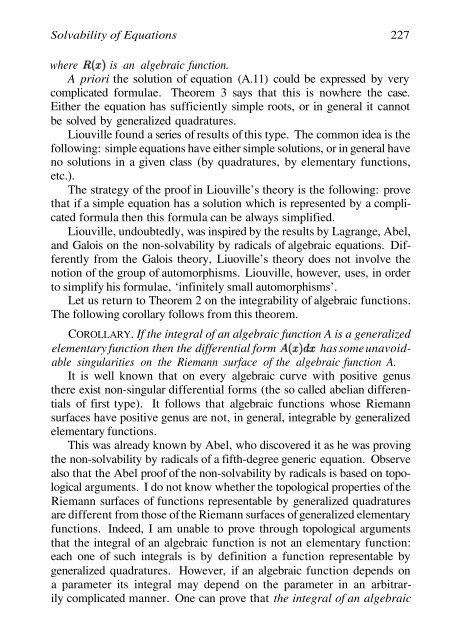Abel's theorem in problems and solutions - School of Mathematics
Abel's theorem in problems and solutions - School of Mathematics
Abel's theorem in problems and solutions - School of Mathematics
Create successful ePaper yourself
Turn your PDF publications into a flip-book with our unique Google optimized e-Paper software.
Solvability <strong>of</strong> Equations 227<br />
where is an algebraic function.<br />
A priori the solution <strong>of</strong> equation (A.11) could be expressed by very<br />
complicated formulae. Theorem 3 says that this is nowhere the case.<br />
Either the equation has sufficiently simple roots, or <strong>in</strong> general it cannot<br />
be solved by generalized quadratures.<br />
Liouville found a series <strong>of</strong> results <strong>of</strong> this type. The common idea is the<br />
follow<strong>in</strong>g: simple equations have either simple <strong>solutions</strong>, or <strong>in</strong> general have<br />
no <strong>solutions</strong> <strong>in</strong> a given class (by quadratures, by elementary functions,<br />
etc.).<br />
The strategy <strong>of</strong> the pro<strong>of</strong> <strong>in</strong> Liouville’s theory is the follow<strong>in</strong>g: prove<br />
that if a simple equation has a solution which is represented by a complicated<br />
formula then this formula can be always simplified.<br />
Liouville, undoubtedly, was <strong>in</strong>spired by the results by Lagrange, Abel,<br />
<strong>and</strong> Galois on the non-solvability by radicals <strong>of</strong> algebraic equations. Differently<br />
from the Galois theory, Liuoville’s theory does not <strong>in</strong>volve the<br />
notion <strong>of</strong> the group <strong>of</strong> automorphisms. Liouville, however, uses, <strong>in</strong> order<br />
to simplify his formulae, ‘<strong>in</strong>f<strong>in</strong>itely small automorphisms’.<br />
Let us return to Theorem 2 on the <strong>in</strong>tegrability <strong>of</strong> algebraic functions.<br />
The follow<strong>in</strong>g corollary follows from this <strong>theorem</strong>.<br />
COROLLARY. If the <strong>in</strong>tegral <strong>of</strong> an algebraic function A is a generalized<br />
elementary function then the differential form has some unavoidable<br />
s<strong>in</strong>gularities on the Riemann surface <strong>of</strong> the algebraic function A.<br />
It is well known that on every algebraic curve with positive genus<br />
there exist non-s<strong>in</strong>gular differential forms (the so called abelian differentials<br />
<strong>of</strong> first type). It follows that algebraic functions whose Riemann<br />
surfaces have positive genus are not, <strong>in</strong> general, <strong>in</strong>tegrable by generalized<br />
elementary functions.<br />
This was already known by Abel, who discovered it as he was prov<strong>in</strong>g<br />
the non-solvability by radicals <strong>of</strong> a fifth-degree generic equation. Observe<br />
also that the Abel pro<strong>of</strong> <strong>of</strong> the non-solvability by radicals is based on topological<br />
arguments. I do not know whether the topological properties <strong>of</strong> the<br />
Riemann surfaces <strong>of</strong> functions representable by generalized quadratures<br />
are different from those <strong>of</strong> the Riemann surfaces <strong>of</strong> generalized elementary<br />
functions. Indeed, I am unable to prove through topological arguments<br />
that the <strong>in</strong>tegral <strong>of</strong> an algebraic function is not an elementary function:<br />
each one <strong>of</strong> such <strong>in</strong>tegrals is by def<strong>in</strong>ition a function representable by<br />
generalized quadratures. However, if an algebraic function depends on<br />
a parameter its <strong>in</strong>tegral may depend on the parameter <strong>in</strong> an arbitrarily<br />
complicated manner. One can prove that the <strong>in</strong>tegral <strong>of</strong> an algebraic

















